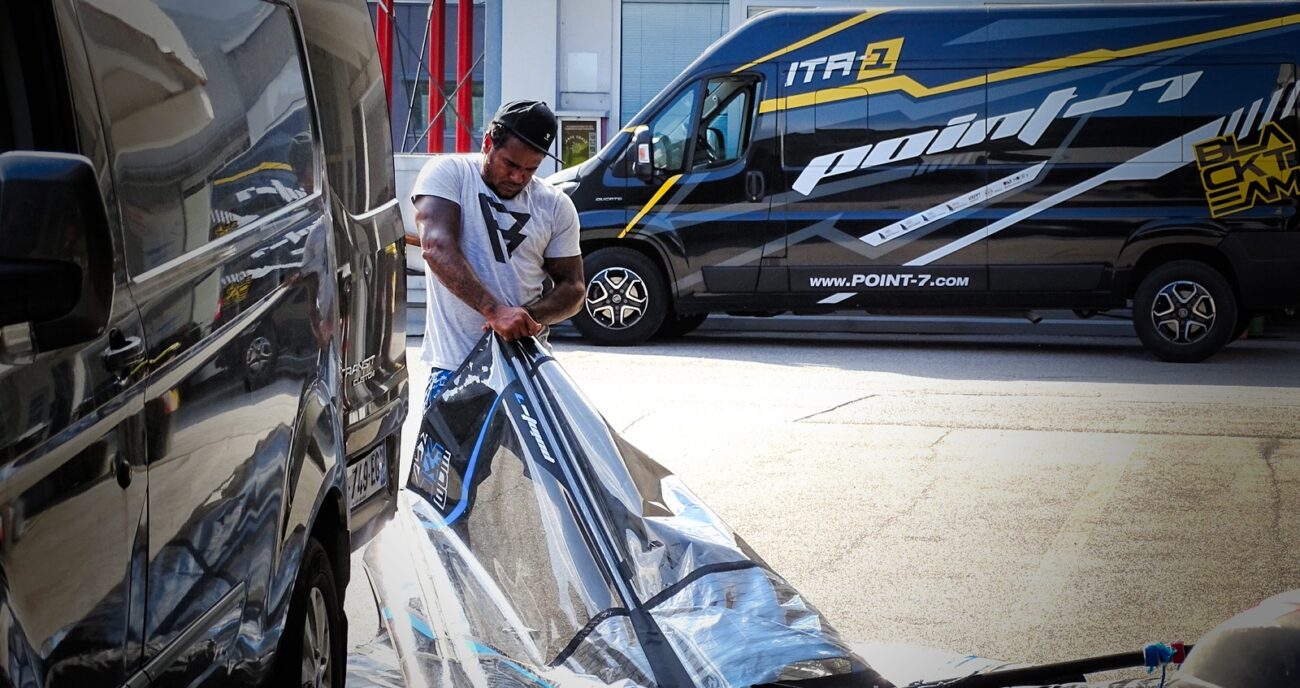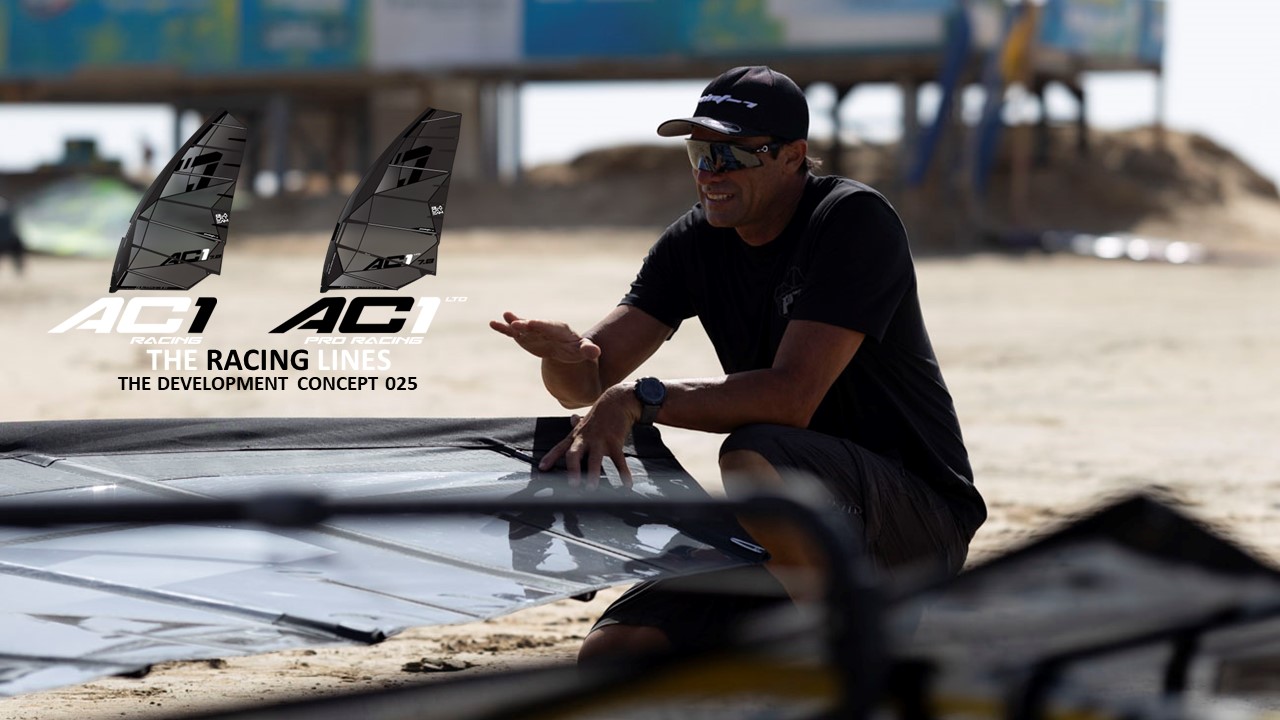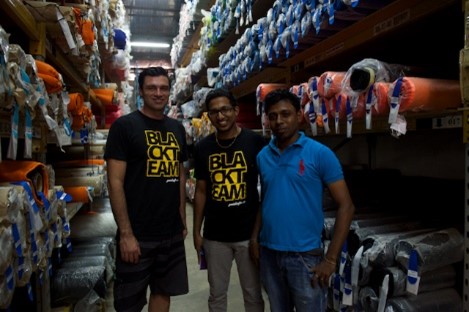
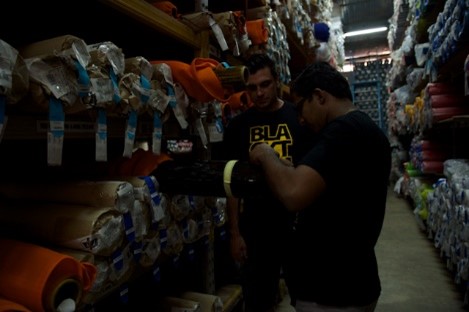
The materials used in sails, as well as their precise design, can dramatically affect the performance and stability of a windsurfing sail. The sail’s shape, stitch patterns, and material properties work together to control how wind interacts with it, ultimately influencing the speed and maneuverability.
In this context, small changes, like adding an extra stitch on a panel to make the graphics more aggressive, or slightly modifying a panel by 3mm, might seem insignificant, but they can have a big impact on how the sail responds to wind forces. The tiniest adjustments can alter the sail’s stability, which is essential for control resulting in a difference in performance.
We’ve recently tested some of the latest high-tech materials, priced at up to 60 euros per meter. While these materials offer a sleek, modern appearance and a lighter feel on land, the results on the water were less than impressive. Despite their advanced look, the reflex response was not as sharp or effective as that of monofilm. In stronger winds, the sail felt heavier and less responsive, as the reflex and stretch properties were not optimized for the dynamic forces at play, highlighting the importance of material choice for achieving the desired performance in varying wind conditions.
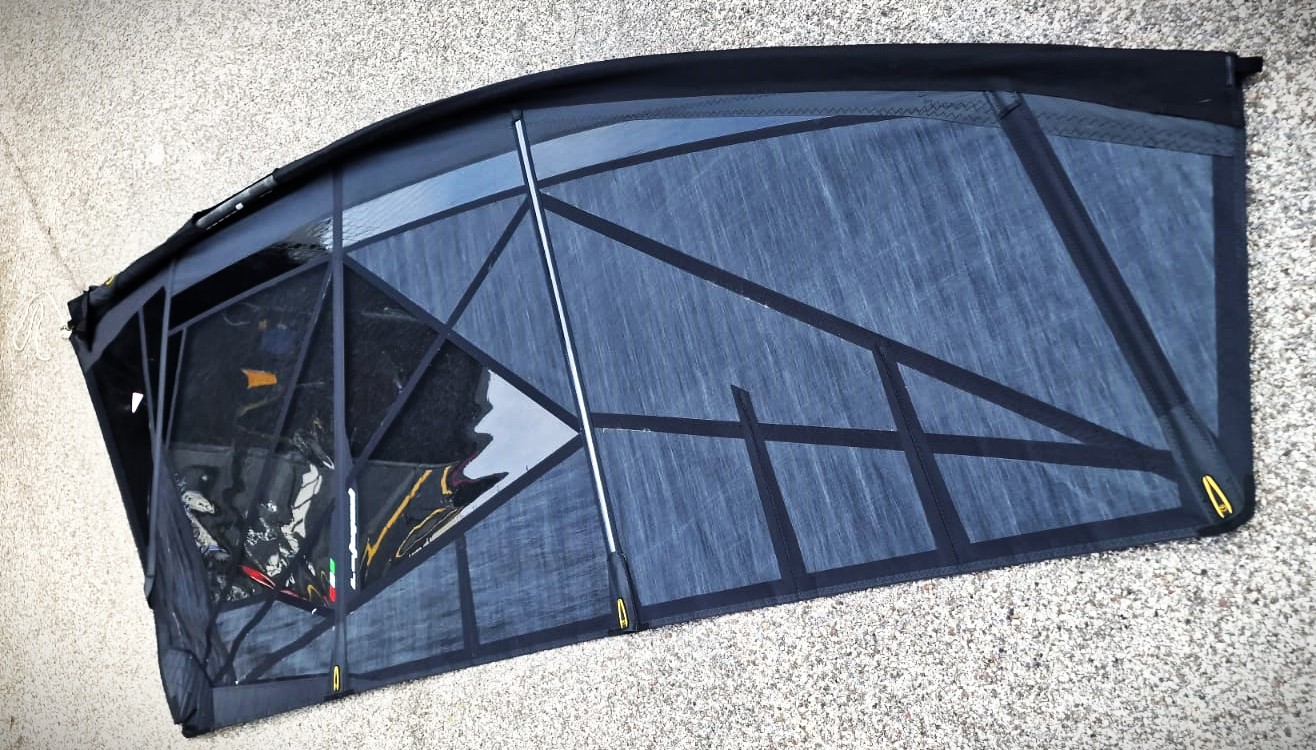
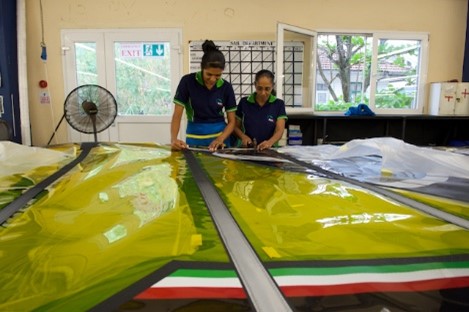
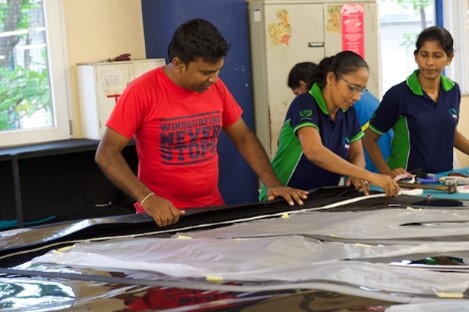
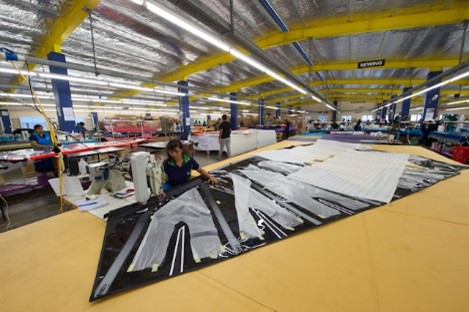
Before we talk about materials let’s see what has changed between the 90’s to now in production. The technology and process of making sails hasn’t drastically changed in terms of the fundamentals, but the costs have gone up due to a few important factors.
Old vs New Fabrics: In the ’90s, sails were primarily made with monofilm, which is cheaper and simpler to produce. Monofilm is clear, but it’s also more vulnerable to UV degradation. Today, sails use more advanced laminates and fabric blends, like Polyester, Mylar, and Scrim, which come with UV protection built in. This adds durability but also increases costs. If you take one of our Point-7 sails, even the window is tinted with ANTI-UV laminates.
Anti-UV Coatings: The newer fabrics with UV-resistant coatings or laminated fibers provide more longevity and maintain their strength better in the long run, but these are more expensive to manufacture than just basic transparent monofilm.
More Customized Designs: Modern sails are often built with much more precise customizations for performance, discipline and durability. This includes advanced shaping techniques, design optimizations and improved sail profiles based on wind conditions or specific uses (race vs recreational). These customizations, while making the sails more efficient, also increase the cost of design and production.
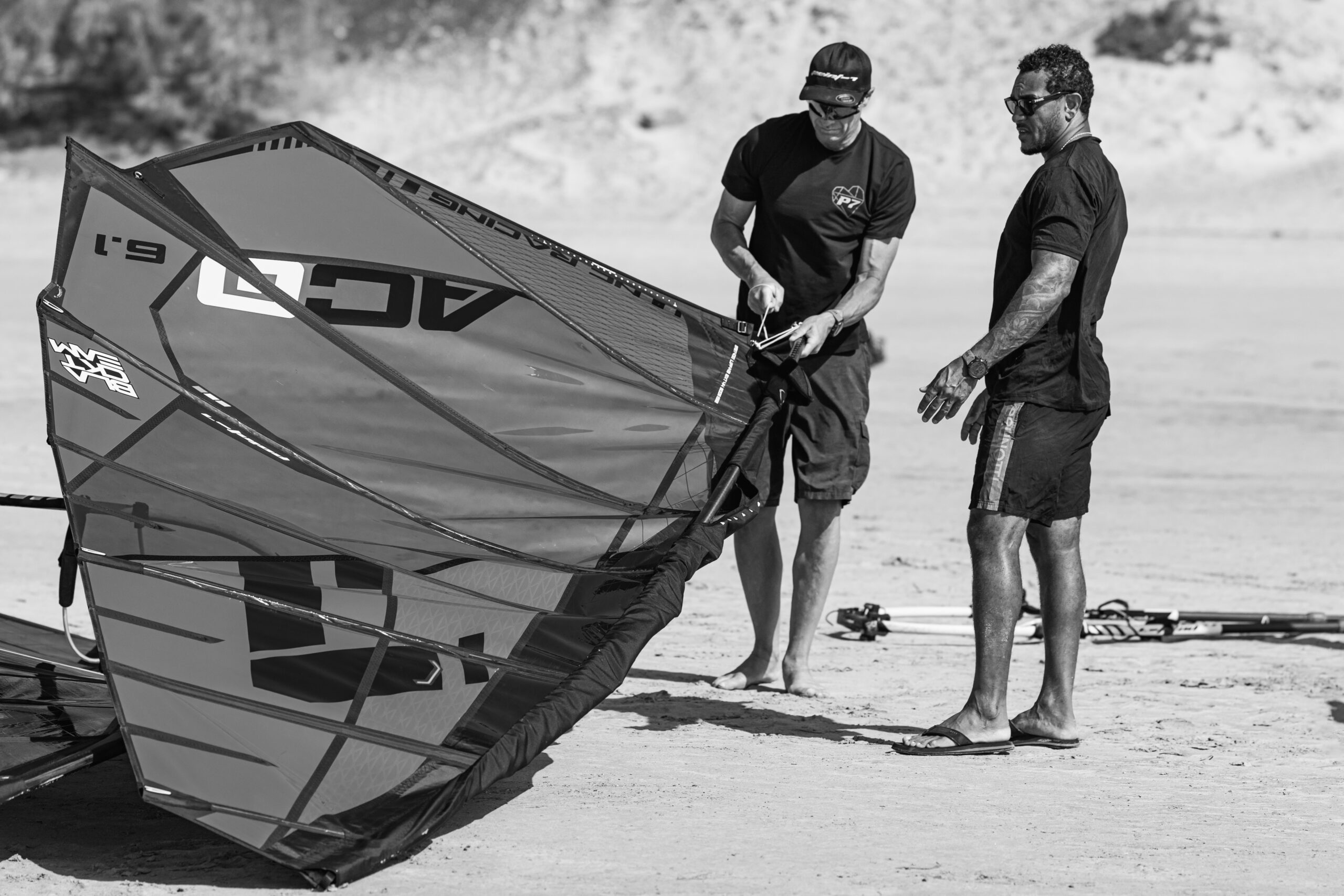
Advanced Accessories: Accessories like reinforcements, battens, straps, and color printing all add to the price. While they may not seem like much individually, over the course of mass production, they contribute significantly to the price.
Handmade Nature: Sails, especially high-performance ones, are still often hand-crafted, which means that skilled labor is required at every stage of production. While the process may be like the ’90s, the expertise needed to handle advanced materials, intricate stitching, and shaping has made the manufacturing process more expensive. To this we also must look at Regulations & Sustainability, inflation, rising of transport and materials, production numbers where there are more niches in each discipline and smaller numbers per size model.
SELECTION OF LAMINATES, X-PLY, MONOFILMS OF DIFFERENT THICKNESS AND COLOURS AND THREADS
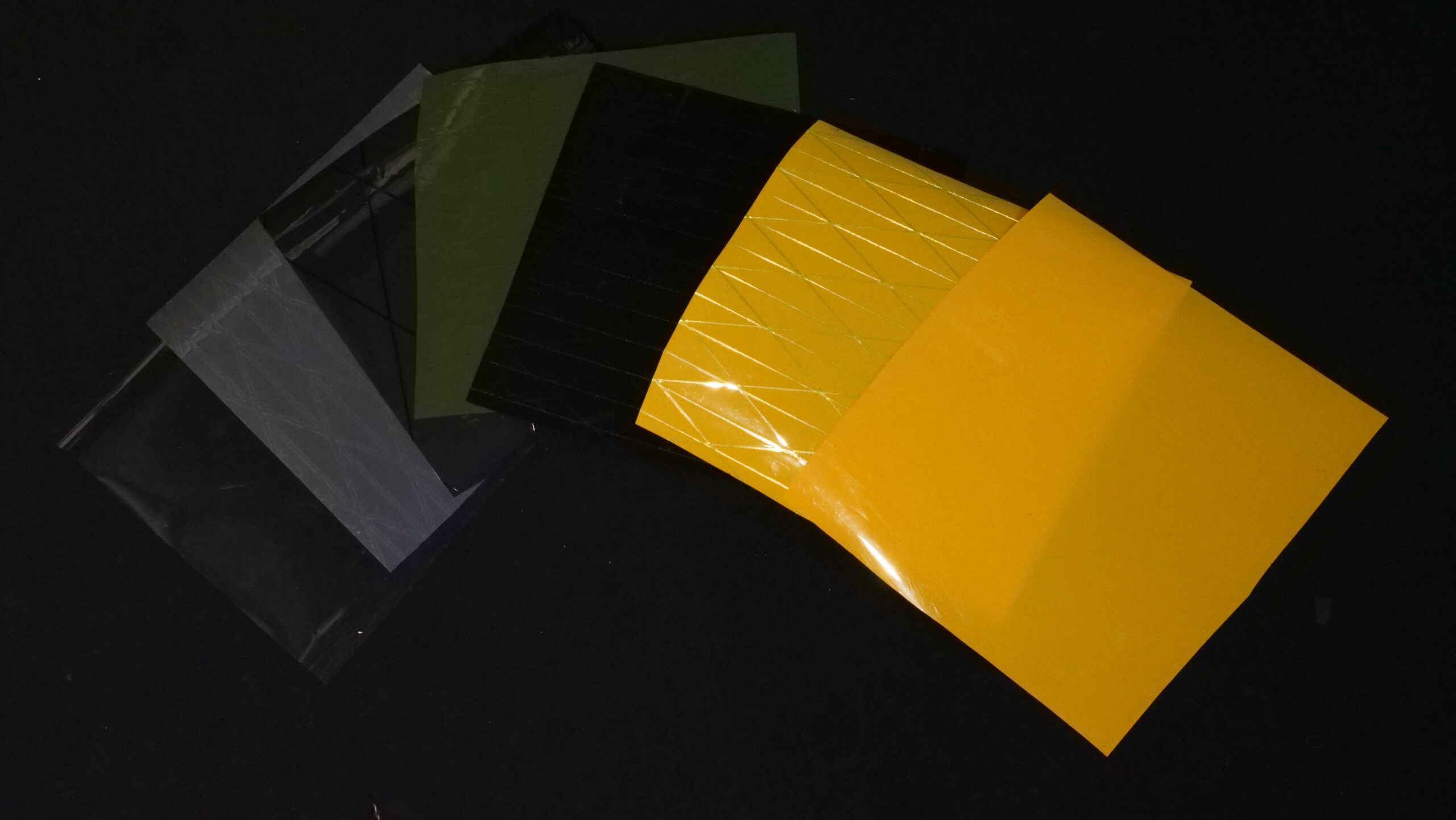
The appearance of a sail can sometimes be deceiving, and it’s essential to distinguish between a graphical or aesthetic change and one that affects the sail’s performance.
When brands make changes to visual aspects like the panel layout or design, they might claim that the sail is still “the same” in terms of performance, especially if the materials and shapes remain unchanged. However, as you noted, even small tweaks to the panel layout can have a significant impact on how the sail behaves in the wind, which is why those adjustments need careful testing. Even if the materials and the overall design stay the same, a slight shift in the way the sail is constructed can alter how it handles the wind pressure, stability, and overall efficiency.
Changing panel layouts purely for aesthetics, without considering performance, is risky. While the look may be fresh, it could unintentionally impact how the sail handles different wind conditions, potentially making it less effective or harder to control. If the design is changed without considering performance, it can lead to a need for additional testing to “recalibrate” the sail back to its previous optimal form. That means more time, effort, and resources spent in testing and tweaking the design to get back to where it was before the change.
Focusing on panel layout adjustments that prioritize performance and leaving the visual changes is sometimes just better continuous R&D, and later changing just material colour, and prints is a smart approach. This way, you can keep the sail’s original characteristics intact while still offering a fresh look. It ensures that the sail’s design remains purposeful, keeping the integrity of its performance without unnecessary compromises. Changing the laminate colours, even with the same mil thickness of material can give a different feeling. Softer or stiffer. Nothing is automatic.
Ultimately, the key is always to take the development seriously, testing every change, even if it’s just a minor aesthetic tweak, to ensure that the sail’s performance doesn’t suffer. That’s how you get the best of both worlds: a great looking sail that performs as expected!
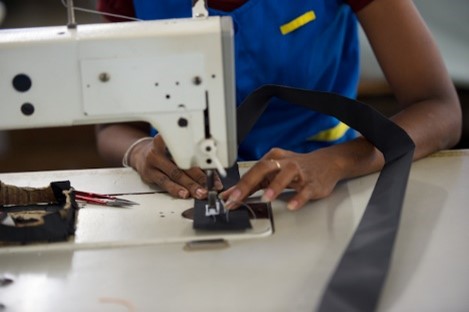
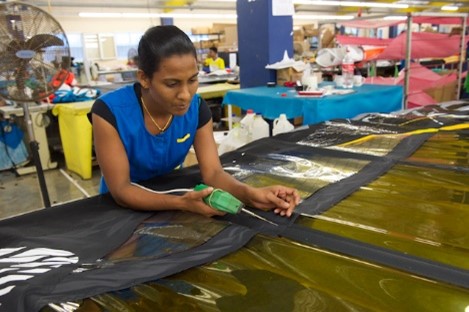
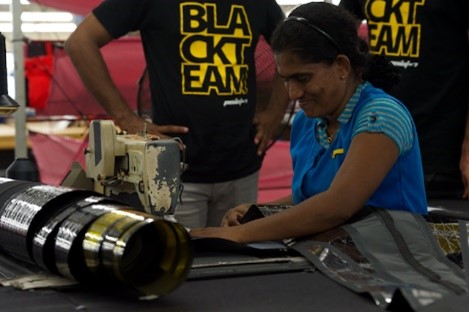
Absolutely, reinforcements are a critical aspect of sail design, and their impact on the sail’s overall performance needs to be carefully considered. Adding reinforcements can help with durability, especially in high stress areas like the corners, edges, and where the sail is attached to the mast or boom. However, as you pointed out, it’s not just about adding more material for strength, it’s about how those reinforcements interact with the rest of the sail.
When you add reinforcements, the area becomes stiffer and less stretchy, which can be a double-edged sword. On the one hand, this can improve the sail’s longevity, making it less likely to tear or stretch out of shape over time. But on the other hand, too much stiffness in the wrong places can negatively affect how the sail behaves in the wind. For example, it might prevent the sail from being able to “depower” properly in stronger winds, making the boat harder to control. Or it could distort the shape of the sail in a way that reduces efficiency, causing it to lose performance.
This is why testing is so important. Even if reinforcements are added with the best intentions, you really need to monitor how those changes affect the sail’s shape, stability, and overall responsiveness. It’s about finding the right balance between durability and performance, and that often requires iterative testing to fine tune the design.
The key is to ensure that reinforcements are placed strategically in areas where extra strength is needed, without compromising the flexibility and performance of the sail. And, of course, every design choice should be backed up by testing under real world sailing conditions to make sure the results match the desired improvements.
Most windsurfing sails are predominantly crafted from monofilm, a versatile material used in varying compositions. There are two primary types of monofilm: the transparent variant, which is priced at approximately one euro per meter, and the laminates, such as our Black Monofilm, which can cost anywhere between eight to nine euros, depending on quality and the specific inserts chosen.
Laminates like the Xply are composed mainly of monofilm and are priced around four euros for the transparent version but can exceed ten to fifteen euros depending on the quality of the UV shields embedded within, as well as the reinforcement ropes integrated to enhance the structural strength of the Xply. The darker the color of the monofilm laminates, the more anti UV glue is incorporated, providing greater protection against the harmful effects of UV rays. This results in improved long-term strength and resistance to degradation, unlike transparent monofilm, printed monofilm, or transparent Xply materials, which are more susceptible to UV damage over time.
For example, our Black Laminate consists of two layers of monofilm, with a unique internal composition that includes anti UV black glue to block harmful rays. Additionally, metallic particle flakes are infused into the glue to further reflect UV radiation, adding both durability and visual appeal. This process also includes a subtle metallic transparent foil placed between the two monofilm layers. This elaborate composition explains the price differential between a basic transparent monofilm and a colored monofilm laminate.
Laminates, in general, offer far superior durability compared to monofilm materials, which is why modern sails now incorporate less X-ply in their construction as it’s less needed if the coloured laminates are used. A key advantage of the colored monofilm laminates is their ability to resist pinching or crushing without resulting in damage or tears qualities that were once more characteristic of transparent monofilm or transparent X-ply. A colored Xply monofilm, therefore, combines both enhanced durability and strength.
CRAMPED TRANSPARENT MONOFILM VS CRAMPTED LAMINATE. TRANSPARENT MONOFILM IS AT RISK TO HAVE THE PINCHES TO OPEN, WHILE THE LAMINATE WILL HOLD.

The thickness of these materials typically ranges from 4 to 5 mil, and each variation in composition influences factors such as stretch, weight, and overall performance. Stretchiness is one of the most important factors in sail design. A sail made from different materials such as replacing a laminate or monofilm window with an Xply one will behave quite differently. It could become stiffer, less balanced, or exhibit reduced power, especially in lighter wind conditions. However, in high wind situations, a more rigid material could enhance stability and control if placed in the right place. Very important. Transparent windows are commonly used in wave sails to ensure clear visibility of the waves when looking through the panel, regardless of the water’s color. While Xply would be a strong choice for durability, the visible strands can be distracting when looking through them. In other disciplines, however, a transparent window isn’t always necessary. You might be surprised to learn that, in practice, you often don’t look directly through the window but rather in front of the mast. In these cases, a light-colored laminate is preferable offering greater strength than transparent monofilm and being less visually disruptive than Xply, ensuring both clarity and performance without sacrificing durability.
When replacing materials purely for marketing or aesthetic reasons, it is essential to test these changes in real world conditions to understand their impact on the sail’s performance. The primary consideration when designing a sail should always be its performance. Thus, a successful sail design is born from knowing exactly where to place Xply and laminates, ensuring the sail’s flex, reflex, and overall dynamics work seamlessly with the mast and mast sleeve. Throughout this process, considerations of visibility, durability, and the sail’s potential weak points must also be integrated.
YELLOW ANTI-UV 4MIL LAMINATE WEIGHT: 10g
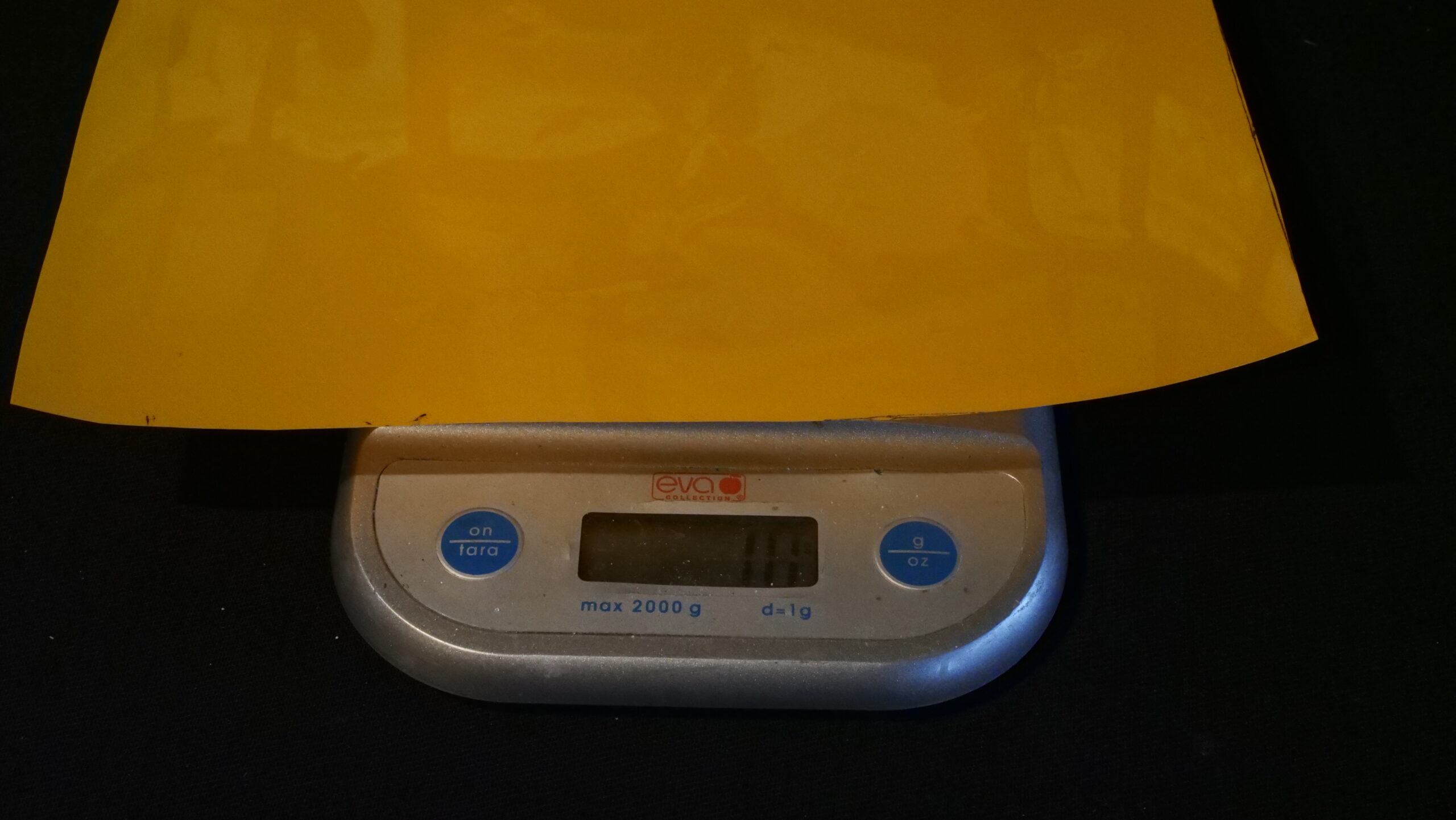
TRANSPARENT MONOFILM WEIGHT: 11g
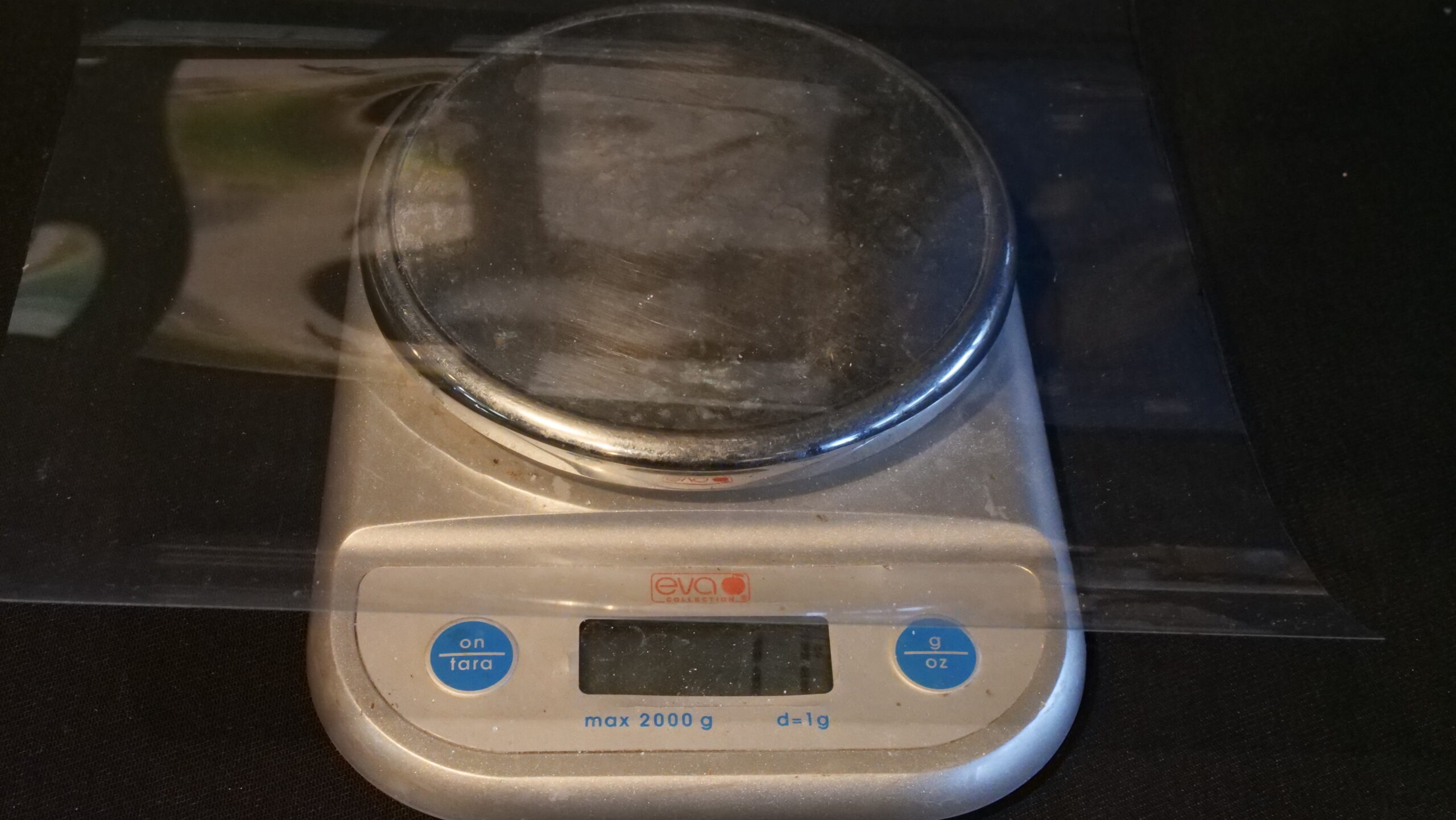
BLACK ANTI-UV X-PLY WEIGHT: 11g
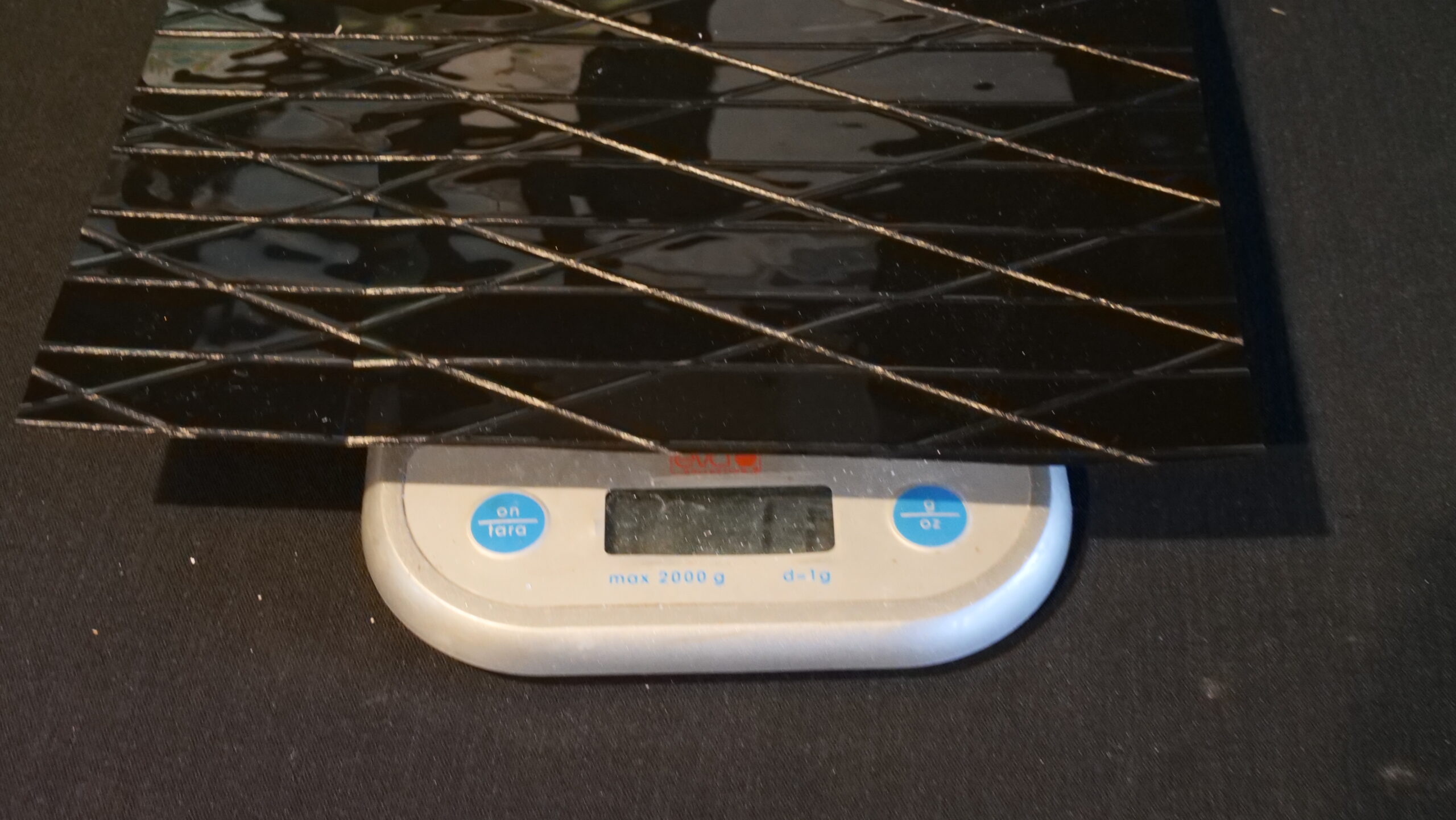
YELLOW ANTI-UV 5MIL X-PLY WEIGHT: 13g
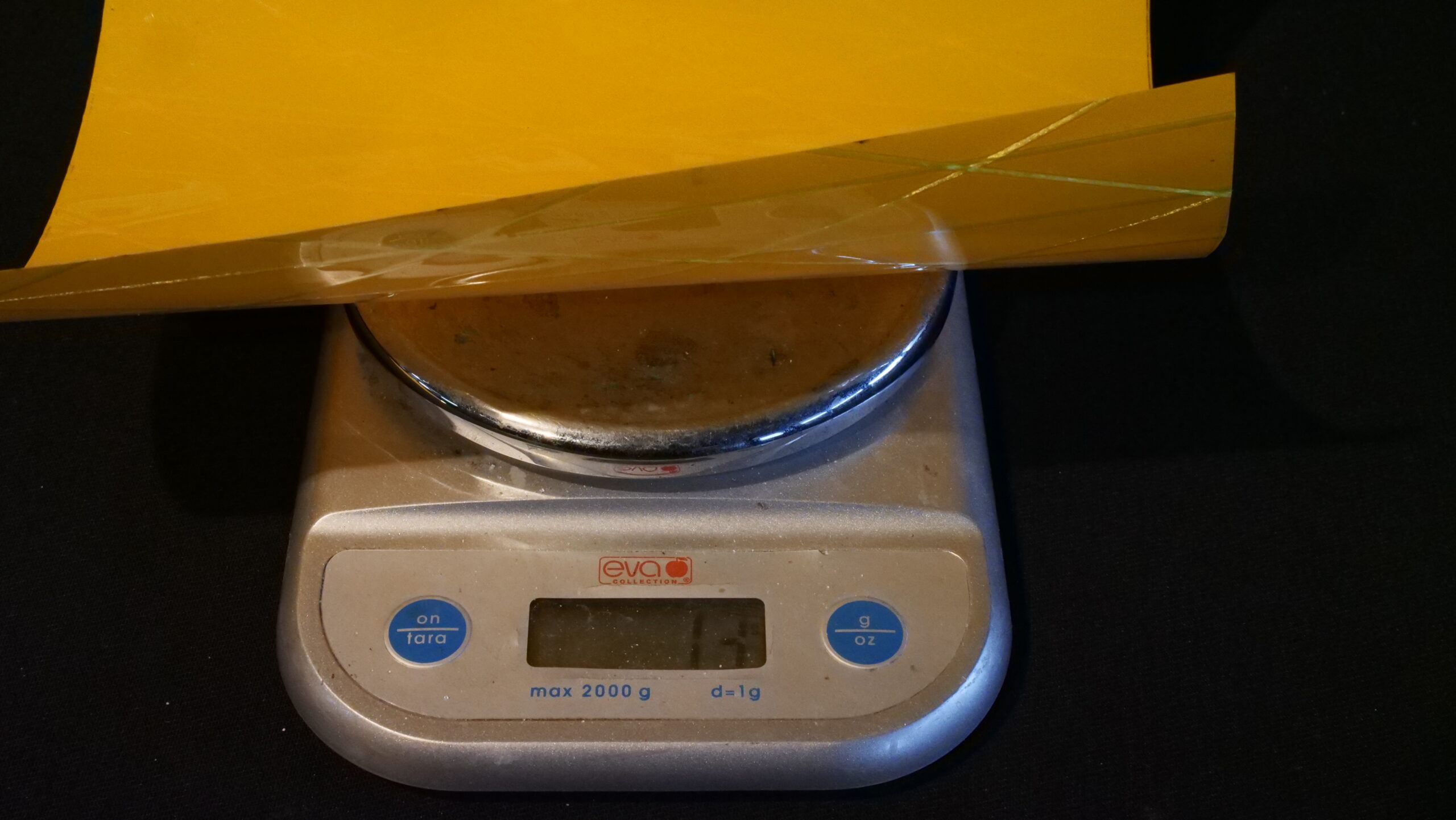
5mil transparent monofilm, even if thicker than a 4 mil laminate will not be as strong as the 4mil laminate as has no anti UV protection and no multiple layers to make it stronger. Laminates can be compared more to transparent X-ply in terms of durability, but with a lighter weight. You will notice that the weights are not huge in difference, but we were having a size of 30cm square sample.
A: AC-2 | 2 CAM RACE SAIL B: AC-1 | PRO RACE SAIL
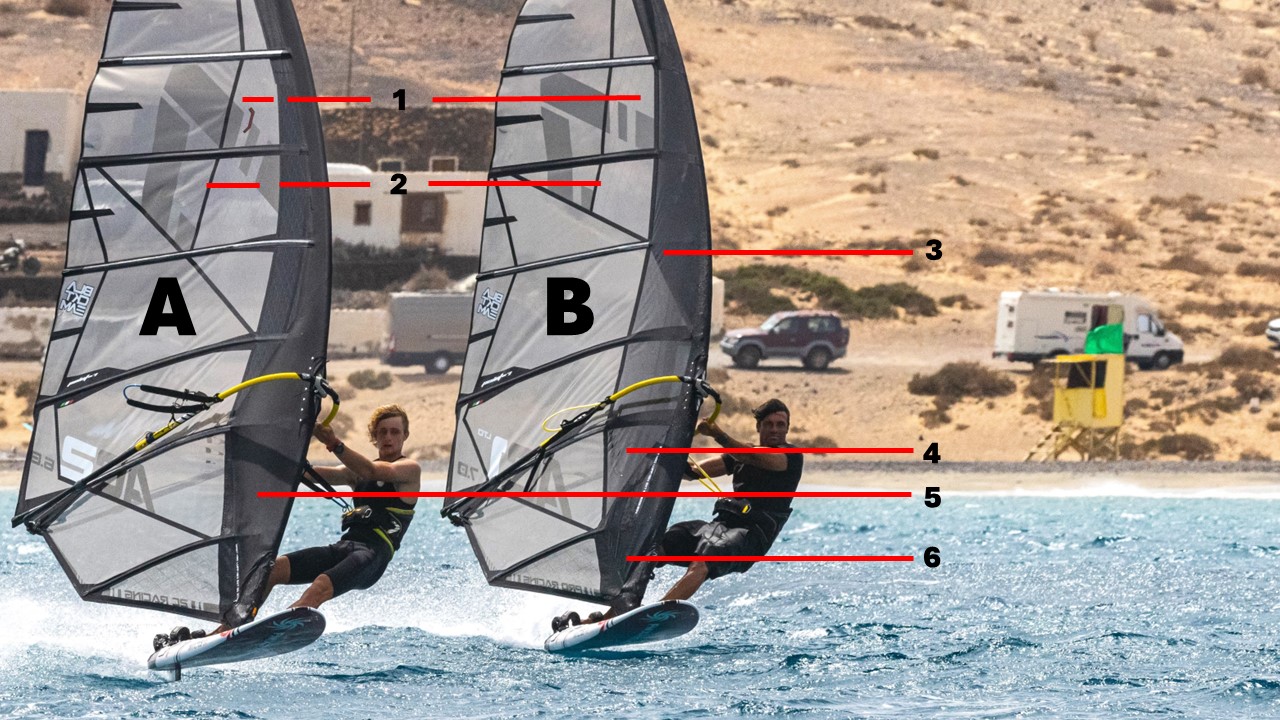
- Xply Anti-Uv Laminate profile stabilizer
- Kevlar Stripes antistretch stabilizers
- Xply Ant-UV Laminate for extra reflex
- Xply Anti-UV Laminate for extra reflex racing visibility window
- Dacron Mast Sleeve for extra comfort, gust and chop absorber
- Dacron Mast Sleeve for extra comfort, gust and chop absorber
The world of materials available for mast sleeves, particularly in racing sails, is vast and varied. We exclusively use black mast sleeves, having discovered that the additional pigment in the material—compared to testing with red or white versions offers a more responsive and harmonious reaction with the reflex speed of the mast. This results in superior acceleration. It’s not merely for practical reasons, like keeping the sleeves cleaner when rigging, or for aesthetic purposes; the color itself contributes to improved performance. We’ve tested this thoroughly, and the color does not affect heat absorption in the mast, so there’s no basis for concern there. If they were detrimental, our pro riders would quickly abandon them, but we are kind of sure to say that they could be helping in the sun, as sometimes we feel the mast sleeve being hot, but the mast inside does not. How the mast is made is also important, and the mast does not break if it is hot. It breaks in the moment that there could be a strong temperature change between very hot to very cold or vice versa, if the mast resins and pre peg are not well developed.
The materials used in mast sleeves also significantly impact sail performance. Depending on their rigidity, they can either support or hinder the dynamic movement of the rig. A reactive, flexible material in the mast sleeve, properly integrated with the sail body and mast, can greatly enhance acceleration and lightness during gusts. This allows the mast to flex optimally, pulling the twist into the right position, ensuring the sail performs seamlessly. In contrast, softer material in the appropriate areas provides forgiveness and comfort, enabling the sailor to maintain a strong stance and continue pushing on the fin without losing control. This is why some race sails incorporate different materials within the sleeve, even compared to a purely dedicated race sail.
The sleeve material must also be durable enough to withstand potential mast breakage and include an internal layer that facilitates easy mast insertion and smooth adjustment during rigging.
In addition to essential reinforcements designed to protect stitching and enhance the durability of weak points, sails often incorporate structural bands to further increase stability. These bands can range from simple lines of Xply to more premium materials like Kevlar. Their purpose is to reduce the stretch of certain areas, thereby improving the reflex of the rig, minimizing sail twist, and contributing to the overall rigidity and performance of the sail.
SLASH FREESTYLE KEVLAR STRUCTURAL BANDS ENHANCING THE CONTROL OF THE REFLEX IN SAIL PANELS.
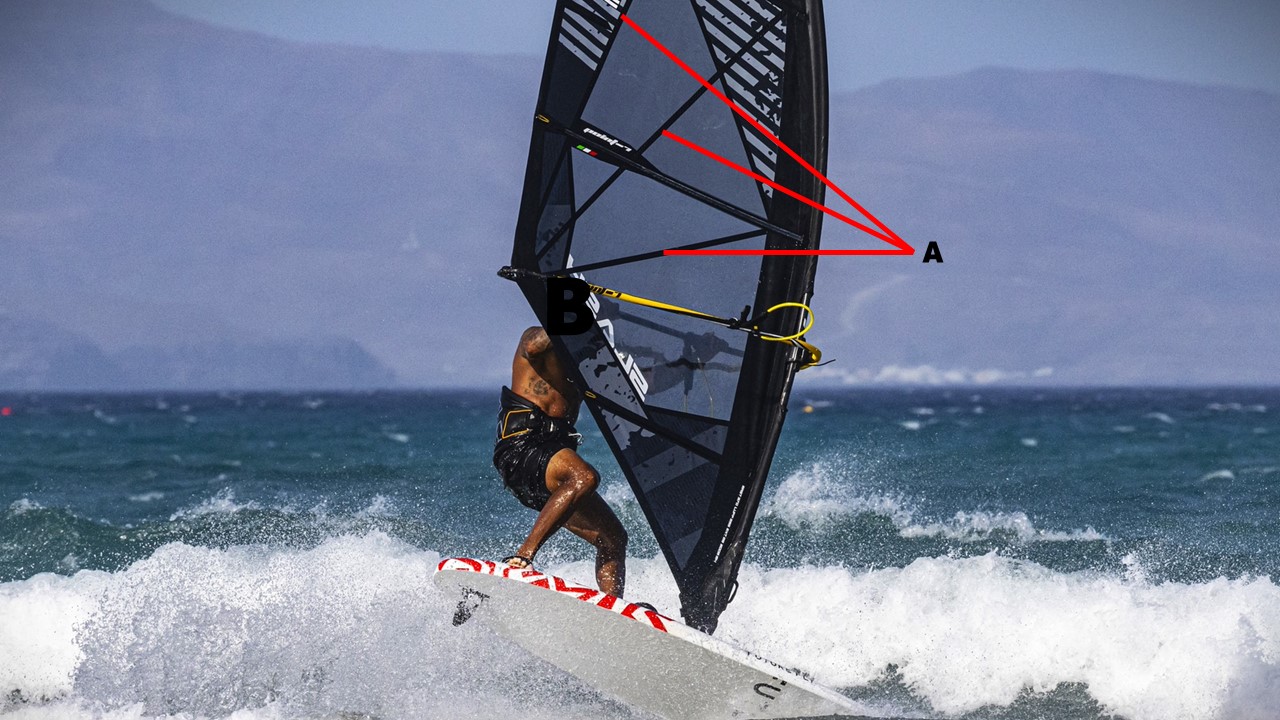
These materials are typically used in areas of the sail where breathability and flexibility are needed. Commonly found next to the mast sleeve, they act as a transition zone between the sail body and the mast sleeve. In wave sails, they function as an “on/off” switch, creating a profile when needed and depowering when not in use. In freestyle sails, they help to increase the profile, providing the necessary pop for air moves. In freeride sails, they enhance comfort by offering more flexibility.
LEFT: DACRON PANEL AT REST KEEPS PROFILE NEUTRAL FLAT.
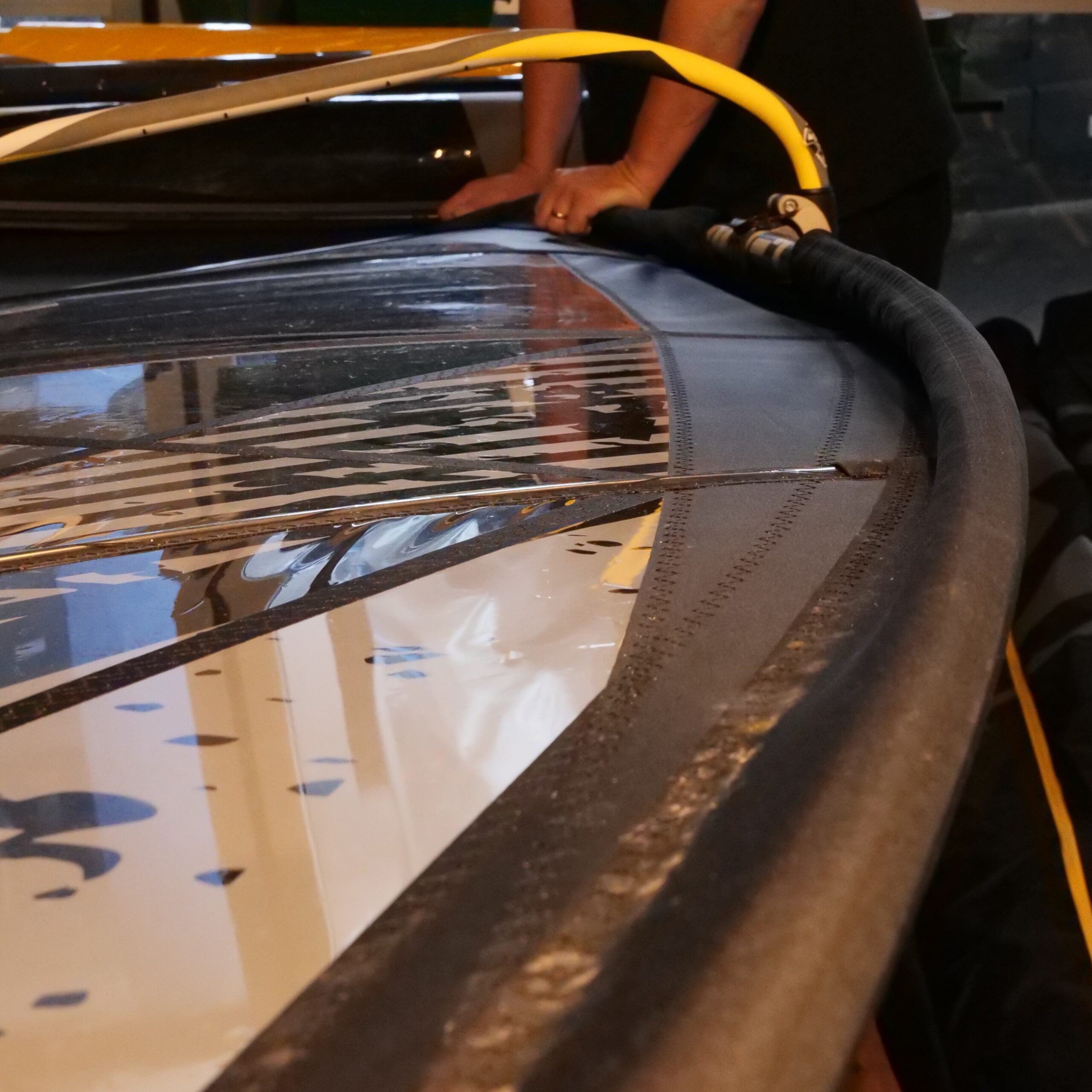
RIGHT: DACRON PANEL AS WIND ENTERS THE SAIL AND MASTS BENDS CREATES AN AMAZING PROFILE.
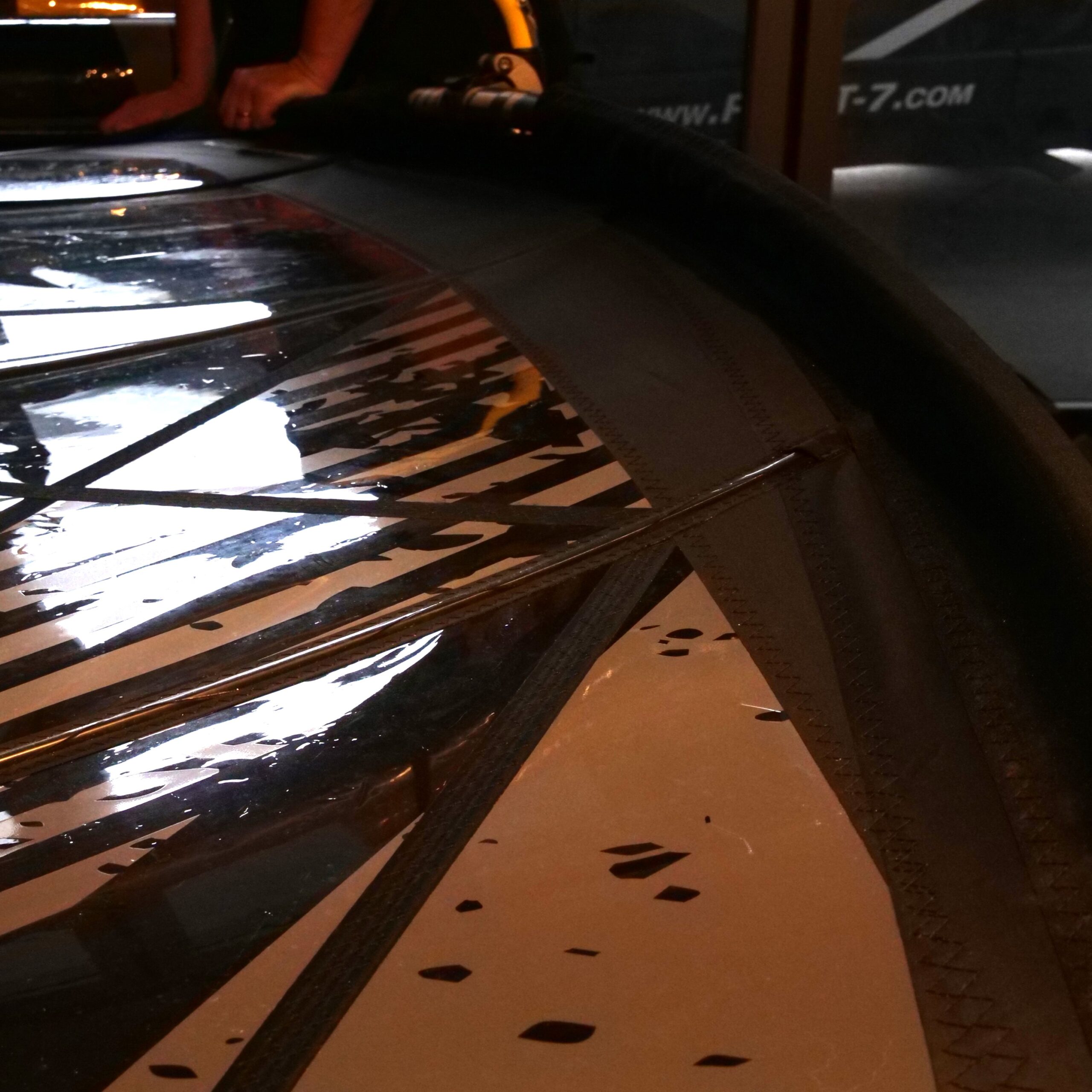
PROFILE DACRON EXAMPLE ON A SLASH FREESTYLE SAIL
In race sails, small quantities of these materials are often stitched along the race sleeve side to smooth out any wrinkles caused by a wide sleeve, though their use could make the sail lose a nice racing crispy acceleration. The width, shape, and placement of these stretchy panels along the luff panel can have a significant impact on sail performance, allowing for tailored customization to match specific conditions.
However, these stretchy materials can lose their structure over time and may begin to stretch unpredictably. To maintain control and prevent sagging, certain techniques and adjustments can help keep the material in shape and optimize its performance.
So, have we covered every material out there for sails? Not even close. What we’ve touched on is just the tip of the iceberg. There’s a whole lot more to dive into, and trust us, we’ll be unpacking each layer of sail design in upcoming articles. Stay tuned for the deeper dive—this is just the beginning!
However, these stretchy materials can lose their structure over time and may begin to stretch unpredictably. To maintain control and prevent sagging, certain techniques and adjustments can help keep the material in shape and optimize its performance.


